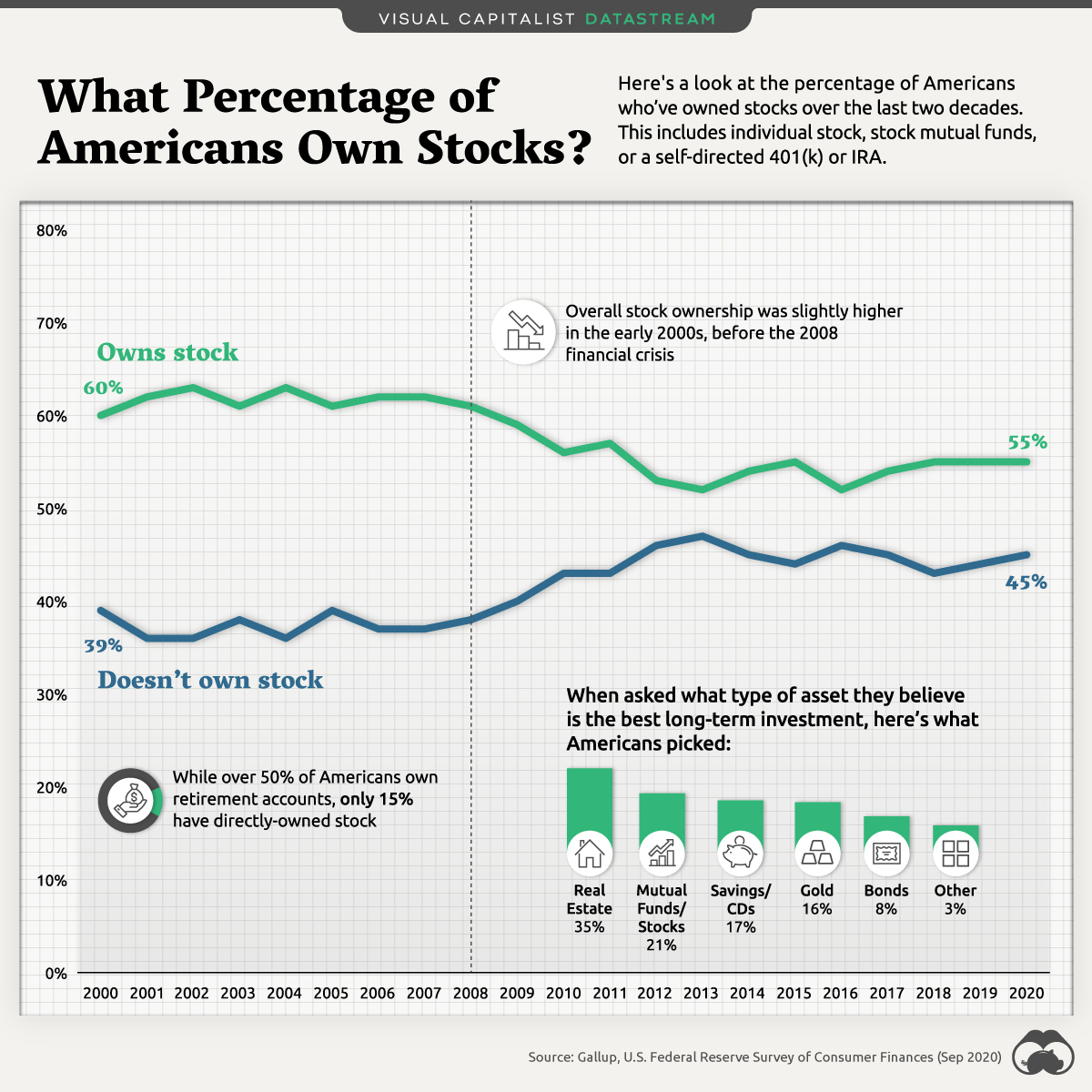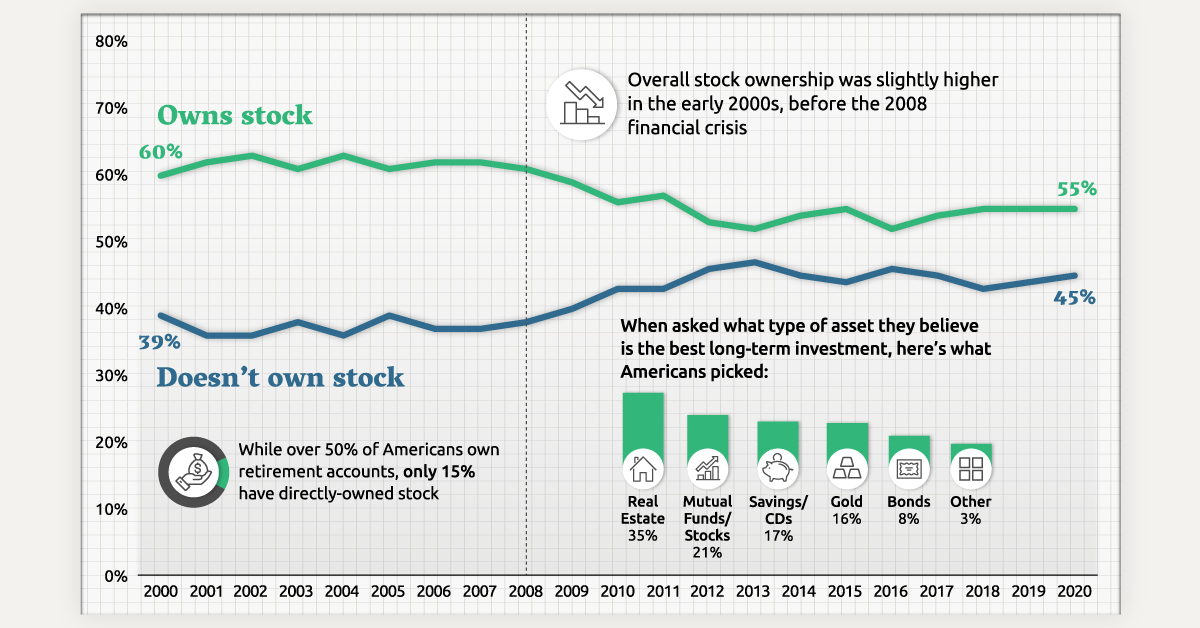Datastream
In One Chart: Two Decades of Stock Ownership in America

The Briefing
- In 2020, approximately 55% of Americans owned some form of stock
- That’s 5 percentage points lower than U.S. stock ownership in 2000
- Stock ownership is strongly linked to household income. Last year, 84% of U.S. households earning $100,000+ owned stock, compared to just 22% of those making less than $40,000
How Many Americans Own Stocks?
2020 was an exceptionally volatile year for the stock market. But how many Americans were directly impacted by last year’s market highs and lows?
In other words, how many Americans own stocks as a part of their investment portfolios?
Two Decades of Stock Ownership in America
Stock ownership in the U.S. has dipped over the last two decades.
In a survey by Gallup, about 55% of Americans claimed to own some form of stock in 2020—either an individual stock, a stock mutual fund, or in a self-directed 401(k) or IRA. This is a significant decrease from 2000, when 60% of Americans owned stock:
| Year | Yes, Owns Stock | No, Does Not Own Stock |
|---|---|---|
| 2000 | 60% | 39% |
| 2001 | 62% | 36% |
| 2002 | 63% | 36% |
| 2003 | 61% | 38% |
| 2004 | 63% | 36% |
| 2005 | 61% | 39% |
| 2006 | 62% | 37% |
| 2007 | 62% | 37% |
| 2008 | 61% | 38% |
| 2009 | 59% | 40% |
| 2010 | 56% | 43% |
| 2011 | 57% | 43% |
| 2012 | 53% | 46% |
| 2013 | 52% | 47% |
| 2014 | 54% | 45% |
| 2015 | 55% | 44% |
| 2016 | 52% | 46% |
| 2017 | 54% | 45% |
| 2018 | 55% | 43% |
| 2019 | 55% | 44% |
| 2020 | 55% | 45% |
*Note: Numbers may not add up to 100% due to rounding.
Stock ownership was relatively high in the early 2000s, but it dipped slightly after the 2007-2008 financial crisis. Since then, it’s hovered around 50-55%.
High Income, High Stock Ownership
While more than half the U.S. population owns some form of stock, ownership is concentrated among higher-income groups.
For example, in 2020, 77% of households making less than $40,000 per year didn’t own stock. In contrast, only 15% of households earning $100,000+ per year weren’t invested in some form of stock:
| Yearly Household Income (USD) | Yes, Owns Stock (2020) | No, Does Not Own Stock (2020) |
|---|---|---|
| $100,000+ | 84% | 15% |
| $40,000 - $99,999 | 65% | 35% |
| <$40,000 | 22% | 77% |
There was also a strong correlation between formal education and stock ownership. In 2020, 85% of Americans who owned stock had a postgraduate degree, compared to 33% who had no formal post-secondary education.
»Interested in the stock market but not sure where to begin? You might enjoy this article, Stock Market Basics: How Do Investors Choose Stocks?
Where does this data come from?
Source: Gallup
Details: Survey results are based on combined data from telephone interviews conducted March 13-22, 2020, and April 1-14, 2020. The data represents a random sample of 2,027 adults, aged 18 and older, living in all 50 U.S. states and the District of Columbia
Datastream
Can You Calculate Your Daily Carbon Footprint?
Discover how the average person’s carbon footprint impacts the environment and learn how carbon credits can offset your carbon footprint.

The Briefing
- A person’s carbon footprint is substantial, with activities such as food consumption creating as much as 4,500 g of CO₂ emissions daily.
- By purchasing carbon credits from Carbon Streaming Corporation, you can offset your own emissions and fund positive climate action.
Your Everyday Carbon Footprint
While many large businesses and countries have committed to net-zero goals, it is essential to acknowledge that your everyday activities also contribute to global emissions.
In this graphic, sponsored by Carbon Streaming Corporation, we will explore how the choices we make and the products we use have a profound impact on our carbon footprint.
Carbon Emissions by Activity
Here are some of the daily activities and products of the average person and their carbon footprint, according to Clever Carbon.
| Household Activities & Products | CO2 Emissions (g) |
|---|---|
| 💡 Standard Light Bulb (100 watts, four hours) | 172 g |
| 📱 Mobile Phone Use (195 minutes per day)* | 189 g |
| 👕 Washing Machine (0.63 kWh) | 275 g |
| 🔥 Electric Oven (1.56 kWh) | 675 g |
| ♨️ Tumble Dryer (2.5 kWh) | 1,000 g |
| 🧻 Toilet Roll (2 ply) | 1,300 g |
| 🚿 Hot Shower (10 mins) | 2,000 g |
| 🚙 Daily Commute (one hour, by car) | 3,360 g |
| 🍽️ Average Daily Food Consumption (three meals of 600 calories) | 4,500 g |
| *Phone use based on yearly use of 69kg per the source, Reboxed | |
Your choice of transportation plays a crucial role in determining your carbon footprint. For instance, a 15 km daily commute to work on public transport generates an average of 1,464 g of CO₂ emissions. Compared to 3,360 g—twice the volume for a journey the same length by car.
By opting for more sustainable modes of transport, such as cycling, walking, or public transportation, you can significantly reduce your carbon footprint.
Addressing Your Carbon Footprint
One way to compensate for your emissions is by purchasing high-quality carbon credits.
Carbon credits are used to help fund projects that avoid, reduce or remove CO₂ emissions. This includes nature-based solutions such as reforestation and improved forest management, or technology-based solutions such as the production of biochar and carbon capture and storage (CCS).
While carbon credits offer a potential solution for individuals to help reduce global emissions, public awareness remains a significant challenge. A BCG-Patch survey revealed that only 34% of U.S. consumers are familiar with carbon credits, and only 3% have purchased them in the past.
About Carbon Streaming
By financing the creation or expansion of carbon projects, Carbon Streaming Corporation secures the rights to future carbon credits generated by these sustainable projects. You can then purchase these carbon credits to help fund climate solutions around the world and compensate for your own emissions.
Ready to get involved?
>> Learn more about purchasing carbon credits at Carbon Streaming
-

 Maps2 weeks ago
Maps2 weeks agoMapped: Average Wages Across Europe
-

 Money1 week ago
Money1 week agoWhich States Have the Highest Minimum Wage in America?
-

 Real Estate1 week ago
Real Estate1 week agoRanked: The Most Valuable Housing Markets in America
-

 Markets1 week ago
Markets1 week agoCharted: Big Four Market Share by S&P 500 Audits
-

 AI1 week ago
AI1 week agoThe Stock Performance of U.S. Chipmakers So Far in 2024
-

 Automotive1 week ago
Automotive1 week agoAlmost Every EV Stock is Down After Q1 2024
-

 Money2 weeks ago
Money2 weeks agoWhere Does One U.S. Tax Dollar Go?
-

 Green2 weeks ago
Green2 weeks agoRanked: Top Countries by Total Forest Loss Since 2001
















